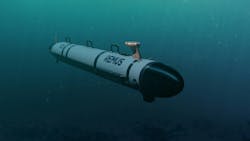Huntington Ingalls to build unmanned underwater vehicle (UUV) for counter-mine warfare and undersea surveys
WASHINGTON – U.S. undersea warfare experts needed a small unmanned underwater vehicle (UUV) for applications like counter-mine warfare and undersea surveys. They found a solution from the Huntington Ingalls Industries Unmanned Underwater Systems segment in Pocasset, Mass.
Officials of the Naval Sea Systems Command in Washington announced a $31.9 million order in December for Lionfish small UUVs. Lionfish is based on the Huntington Ingalls REMUS 300 UUV, and is for critical underwater missions.
Lionfish UUV
The Lionfish UUV incorporates advanced modularity and an open-systems architecture into a compact, man-portable design. Lionfish is the next generation Mk18 Mod 1 Swordfish program, which also uses HII’s REMUS technology.
The REMUS 300 is built for military and commercial applications like mine countermeasures, anti-submarine warfare (ASW), and undersea surveys. It an conduct counter-mine operations down to 1,000 feet, and uses side-scan sonar for autonomous large-area underwater surveys that enable operators to review and classify mine-like objects.
The UUV can be moved by two people, and can deploy rapidly from any vessel. Its side-scan sonar and precision navigation provide data to locate targets, including downed aircraft and sunken ships.
Key Features include 30-hour mission duration; speeds to 5 knots; flexible energy options; open architecture; modular and reconfigurable; and removable 1-terabyte hard drive to gather mission data.
Anti-submarine warfare
The UUV offers capabilities such as counter-mine warfare, rapid environmental assessment; marine archaeology; offshore oil and gas; and renewable energy. Customer-defined missions include intelligence, surveillance, and reconnaissance; and ASW.
The REMUS 300 offers three rechargeable battery options: a 1.5 kilowatt-hour battery; 3 kilowatt-hour battery; and 4.5 kilowatt-hour battery.
Versions of the UUV are 7.5 and inches in diameter; 80, 94, and 104 inches long; weigh 107, 129, and 155 pounds; offer endurance of 10-, 20-, and 30-hours; and ranges of 29, 59, and 89 nautical miles. The UUV has optional camera payloads; gap-filling sonar; environmental sensors, Iridium communications, and nickel-metal-hydride batteries.
On this order Huntington Ingalls will do the work in Pocasset, Mass.; and Hampton, Va., and should be finished by next December. For more information contact Huntington Ingalls Unmanned Underwater Systems online at https://hii.com/what-we-do/capabilities/unmanned-systems/, or Naval Sea Systems Command at www.navsea.navy.mil.
About the Author
John Keller
Editor-in-Chief
John Keller is the Editor-in-Chief, Military & Aerospace Electronics Magazine--provides extensive coverage and analysis of enabling electronics and optoelectronic technologies in military, space and commercial aviation applications. John has been a member of the Military & Aerospace Electronics staff since 1989 and chief editor since 1995.

